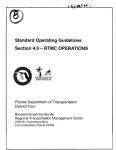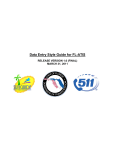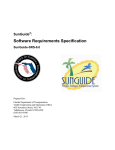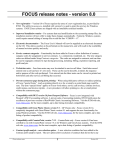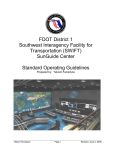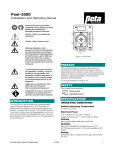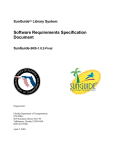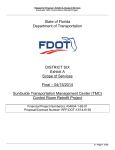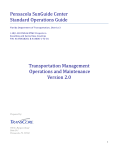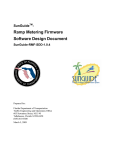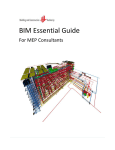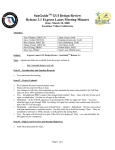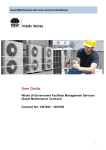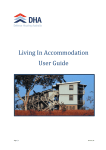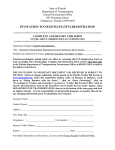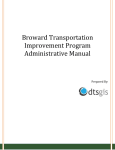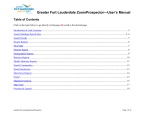Download 10 SOG Section 4.0 Operations
Transcript
Standard Operating Guidelines Section 4.0 - RTMC OPERATIONS Florida Department of Transportation District Four Broward Smart SunGuide Regional Transportation Management Center 2300 W. Commercial Blvd. Fort Lauderdale, Florida 33309 Florida Department of Transportation BROWARD SMART SUNGUIDE REGIONAL TRANSPORTATION MANAGEMENT CENTER STANDARD OPERATING GUIDELINES Operations 4.0.0 Select bookmarks in the left hand panel to view the table of contents. Use the 'find' box above to search for specific words or phrases in the document. Version: 6.0 January 15, 2012 Page 1 of 1 Florida Department of Transportation BROWARD SMART SUN GUIDE REGIONAL TRANSPORTATION MANAGEMENT CENTER STANDARD OPERATING GUIDELINES 4.0.0 Operations Operations Version: 6.0 January 15, 2012 Page 1 of 1 Florida Department of Transportation BROWARD SMART SUNGUIDE REGIONAL TRANSPORTATION MANAGEMENT CENTER STANDARD OPERATING GUIDELINES Operations Control Room Management 4.1.0 Control Room Management Version: 6.0 January 15, 2012 Page 1 of 1 Florida Department of Transportation BROWARD SMART SUNGUIDE REGIONAL TRANSPORTATION MANAGEMENT CENTER STANDARD OPERATING GUIDELINES Control Room Management Operations Rules and Guidelines 4.1.1 OVERVIEW The control room is a high profile area and will be the focal point for the RTMC. This central position results in a certain amount of tours and meetings taking place in the RTMC and warrants guidelines in order to maintain professionalism at all times. The commission or omission of any act which constitutes a violation of any of the regulations, directives, policies or procedures contained herein will be grounds for disciplinary action. POLICY • No food or drinks are allowed in the control room; only bottled water in a container with a cap is permitted. • Storage lockers are available in the locker rooms located within the restrooms to store all personal belongings while on duty. No personal belongings are allowed in the control room or anywhere visible. • Control room telephones are not to be used for sending or receiving personal calls, except for emergency situations. • Personal cell phone calls are to used during breaks outside the control room unless specifically directed to do otherwise by an appropriate supervisor; this includes texting and the use of Smart Phones. Other forms of electronic communications or the utilization of personally owned equipment such as a PC or video game is not permitted within the control room. • During tours or meetings in the control room, the highest level of professionalism and diligence to operations is mandatory. Visitors may include; government officials, visitors from different states and countries, Traffic Incident Management Team Members and various other groups and individuals. • RTMC Operators, while on duty, are not allowed visits from friends except during break periods. Visits must be approved by a Supervisor or Manager. Visitors are not permitted in the control room unless approved by a Supervisor or Manager. • Standard Operating Guidelines, reference materials and equipment are to be kept neatly in place and readily available at each workstation. Version: 6.0 I January 15, 2012 Page 1 of2 Florida Department of Transportation BROWARD SMART SUNGUIDE REGIONAL TRANSPORTATION MANAGEMENT CENTER STANDARD OPERATING GUIDELINES Control Room Management Operations Rules and Guidelines 4.1.1 • All workstations must be maintained in an orderly manner including mouse, mouse pads, keyboards, pens, note pads and RTMC manuals. • Any work related items that are normally stored in cabinets or drawers must be stored properly when not in use. • When completed with each shift, help prepare the next RTMC Operator for their shift, by straightening up the workstation. Since the workstations are shared, it is very important any mess be cleaned up. • Personal business shall be conducted while on break. • No profanity or foul language will be allowed; proper office etiquette shall be maintained at all times. Business must be conducted in low volume, or silence maintained, so as not to interfere with other workstation performance. • No sleeping. If you are unable to stay awake, contact with the RTMC Operations Supervisor or the RTMC On-Call Manager should be made immediately. • Downloading files, listening to music, watching TV and playing games are not permitted. • Unauthorized screen savers or wallpapers shall not be displayed on workstation computers. • Removal of the panels at any work station is not permitted. The removal of these panels should be done by authorized personnel only for the purpose of maintaining the computer network and other necessary equipment. • The RTMC Operator is required to come into work in uniform and with a neat and professional appearance. Attire must be business casual (black, navy or khaki pants/skirts) with a SunGuide logo shirt. Business casual attire is defined as: suits, dresses, skirts, dress pants or khaki's in black, navy blue, tan or brown with dress shoes. No sneakers, tennis shoes, or flip-flops allowed. • Jeans are permitted on Fridays, weekends, and overnight; provided they are in good condition and they must be worn with a SunGuide logo shirt. Jogging attire and tank/halter tops are not deemed acceptable at any time • Use of Broward County Traffic Engineering Division equipment or space is not allowed without written permission. Version: 6.0 January 15, 2012 Page 2 of2 Florida Department of Transportation BROWARD SMART SUNGUIDE REGIONAL TRANSPORTATION MANAGEMENT CENTER STANDARD OPERATING GUIDELINES Operations I Control Room Management Shift Scheduling 4.1.02 POLICY In order to provide coverage 24 hours a day, seven days a week Operators are scheduled to work 2 12-hour shifts and 2 8-hour shifts each week on a rotating basis. In most instances, the 12-hour shifts are scheduled Saturday through Tuesday and the 8-hour shifts (including swing shifts) are scheduled Wednesday through Friday. Overtime is based on business needs and must be approved in advance. Operators should be advised that shift start and end times, as well as scheduled days, are subject to change based on business need. BREAKS One way the RTMC ensures proper coverage, especially during high traffic times, is by limiting the times breaks and lunch may be taken. The RTMC allows two 15 minute breaks during the 8-hour shifts and three 15 minute breaks during the 12-hour shifts. Lunch breaks are 30 minutes in duration and require the Operator to clock out when leaving for lunch and clock back in when returning. During the day shifts, RTMC Operators are not permitted to take a break or lunch during the high peak hours of 6 am to 9 am. During the night shifts breaks and lunches are not permitted between the hours of 3:30 pm and 6:30 pm. ATTENDANCE RTMC Operators are responsible for clocking in and out using the Time Clock Plus time clock located outside of the southeast door of the control room. Clock in and out for the following: • Start and end of shift • Lunch start and end Operators are also responsible for accurately completing a weekly timesheet and submitting the form in a timely manner. Normally, timesheets are required to be submitted to Supervisors for review by Thursdays of each week. Each operator is responsible entering the hours daily as they work them and electronically submitting and printing them for supervisor review. Reporting for Duty RTMC Operators will report to the control center, by the scheduled start of the work shift unless otherwise authorized by an appropriate supervisor. Version: 6.0 January 15, 2012 Page 1 of 5 Florida Department of Transportation BROWARD SMART SUNGUIDE REGIONAL TRANSPORTATION MANAGEMENT CENTER STANDARD OPERATING GUIDELINES I Operations I Control Room Management Shift Scheduling 4.1.02 If due to illness or other circumstances RTMC Operators cannot report by the assigned time, but will be able to report, the employee must contact his/her immediate supervisor before the start of the shift to explain the situation and to provide an estimated time of arrival. RTMC Operators are expected to report for their assigned shift except when prevented by injury, illness, or emergency situation. Any leave of absence, with or without pay, shall be approved prior to the leave commencing unless emergency circumstances prevent such action. Leave without proper approval will be addressed through the issue resolution process according to protocol established by AECOM. Working a Full Shift The current Saturday-Friday, 24 hours per day schedule contains a combination of 12 and 8 hour shifts. RTMC Operators are expected to remain for their entire shift unless excused by a supervisor or manager. If an employee needs to leave before the end of their assigned shift due to illness or other circumstances, the employee must seek the approval of his/her supervisor or designated alternate prior to leaving. Work shifts include 24 hours a day, seven days a week as well as holidays and weekends. A 30 minute overlap is in place for all shifts to allow outgoing Operators to debrief those relieving them. In the event the Operator coming on shift is late/absent or at the request of a supervisor, RTMC Operators may be required to remain at their workstations until the next shift is available to begin. All RTMC Operators are required to remain at their workstations until the end of their scheduled shift at minimum. Schedule change requests should be arranged with other RTMC Operators whenever possible. Once arranged, requests must be submitted on a Shift Change Request Form (located on the Public domain in the Forms folder and on the Intranet) and submitted to a supervisor for approval. Schedule change requests must include a purpose. Requests for change will not be approved for the sole purpose of extending scheduled days off and such requests may result in disciplinary action. Schedule change requests must not result in any employee being scheduled to work in excess of 12 ~ consecutive hours. Employees that work in excess of 8 ~ hours are allowed a third 15 minute break. Availability Status All RTMC Operations personnel shall provide themselves with proper telephone service so that they may be called in to the RTMC with the least possible delay, should the need arise. Supervisors shall be informed of these numbers, as well as any changes in either addresses or telephone numbers that ! may occur during the course of employment. Version: 6.0 January 15, 2012 Page 2 of 5 Florida Department of Transportation BROWARD SMART SUNGUIDE REGIONAL TRANSPORTATION MANAGEMENT CENTER STANDARD OPERATING GUIDELINES Control Room 4.1.02 Shift Scheduling I Management - - - - - --.L.------""'--------I6::============....!I-----j1 Operations , The work schedule shall be made available in writing to the Control Room staff as early as possible. In the event an employee is unable to work a shift according to the assigned schedule it is the responsibility of the employee to arrange to switch with another employee and complete a Shift Change Request and submit to his/her supervisor for approval. The employee also may notify their Supervisor to see if other arrangements can be made to be certain the shift is covered. Overtime and Extra Hours RTMC Operators may be required under certain conditions to remain past their regularly assigned schedule to work in excess of 40 hours per week. Staff volunteering or agreeing to work overtime (OT) must get official approval from the supervisor. To monitor and track all overtime, you must list the hours and reason for overtime on the Manual Timesheet Additional Notes page can be found in the P:\Timesheets & Expense Report\Manual Time Sheet Additional Notes.xls directory. Once entered, print a copy of the form and attach it to your timesheet. An Overtime Approval Form must be completed for all requests for OT outside normal business hours (e.g. weekend special events or construction activities) and requests to work extra hours on special tasks outside of normal 8 hour shift. RTMC Operators may not volunteer for overtime and expect compensation without appropriate authorization. Non-exempt RTMC Operators who are required to work hours beyond their normal assigned 8 hour shift or on days when they are not scheduled must document the hours by punching in/out on the time clock and listing the hours on their timesheets according to the protocol established by AECOM. Shift Change The Shift Change Approval Form has been developed for operators who desire to make adjustments to their work schedule. If an operator is scheduled for a time or date that conflicts with a prior appointment, engagement or plan, the operator has the option to make arrangements with another operator to switch/change shifts. Once the two operators agree on the shift change, a Shift Change Approval Form must be completed and approved by the supervisor (or a manager in his absence). Abandonment of Position RTMC Operators who are absent without authorization or notifying a supervisor for three consecutive workdays shall be deemed to have abandoned the position and to have resigned as per AECOM policy. Version: 6.0 January 15, 2012 Page 3 of 5 Florida Department of Transportation BROWARD SMART SUNGUIDE REGIONAL TRANSPORTATION MANAGEMENT CENTER STANDARD OPERATING GUIDELINES Operations Control Room Management Shift Scheduling 4.1.02 PLANNED LEAVE REQUEST SMART SunGuide RTMC provides eligible RTMC Operators leave for a variety of reasons. The following discussion summarizes the Vacation and Absence policies: • SMART SunGuide RTMC will attempt to grant all RTMC Operators vacation at the time they desire to take it. However, adequate staffing must be maintained at all times. • Vacation time MUST be scheduled in advance with prior written approval and in accordance with protocols established by AECOM. Where conflicts develop, they will be resolved as fairly as possible. With the exception of requests for time off on or near holidays, preference will generally be given to the RTMC Operator who makes the earliest request. • In order for vacation/PTO time to be approved, operators MUST have accrued enough PTO in order to take the requested time off. In order to maintain adequate staffing and in fairness to all RTMC Operators, requests for time off, on holidays and during holiday weekends, will be decided on a case by case basis. • To apply for Vacation or Planned Absences, or to inquire as to what dates/times may be available, a RTMC Operator should contact a Supervisor or Manager. • All requests for time off should be submitted on a SMART SunGuide RTMC Time-Off Request Form. • A RTMC Operator applying for leave that is more than one day in duration will be required to give a minimum of one calendar week advance notice; requested leave of three days through 4 days in duration will be required to give a minimum of two calendar weeks advance notice; leave of 5 days or more requires four calendar weeks advance notice. Travel arrangements should not be made until the Time-Off Request Form has been approved and signed by a Supervisor or Manager. • A RTMC Operator applying for leave will be asked when they want the period to begin and end. A Supervisor or Manager will inform the RTMC Operator the leave has been approved and will also tell the RTMC Operator what requirements must be fulfilled, such as certification of a health condition, the employee must fulfill. • All Vacation or Planned Absences are granted for a specific period of time. A RTMC Operator who foresees being unable or unwilling to return to work at the end of the leave period should apply for any other leave for which the RTMC Operator is eligible, including an extension of the Version: 6.0 January 15, 2012 Page 4 of 5 Florida Department of Transportation BROWARD SMART SliNGUIDE REGIONAL TRANSPORTATION MANAGEMENT CENTER STANDARD OPERATING GUIDELINES r-------------,---------IF==============;r------tI Operations Control Room Management Shift Scheduling 4.1.02 current leave. The SMART SunGuide RTMC reserves the right to terminate a RTMC Operator who does not return to work at the end of the approved leave period, according to protocol established by AECOM. UNPLANNED LEAVE REQUEST Unplanned leave is defined as a period of unscheduled absence resulting from unforeseen circumstances including personal illness, injury, medical quarantine and family emergency. RTMC Operators unable to report as assigned due to illness, injury or other special circumstances shall notify their immediate supervisor at least 8 hours before the start of the work shift whenever possible. In the event the immediate supervisor is not available, the next available in line supervisor or on-call supervisor shall be notified. Voice mail and email messages will not substitute for direct contact. A minimum of 2 hours notice should be provided in order to allow time to contact a replacement if needed. Failure to notify a supervisor or manager no later than 30 minutes after scheduled start time may be considered unexcused. Employees shall contact their supervisor on each day of absence except during periods of extended illness provided prior arrangements have been made with the supervisor. Appropriate documentation or approval from a manager and/or Human Resources is required for the following: • Any unplanned absence exceeding 2 working days • Any absence where more than 2 single non-consecutive days are taken within the same two week period (i.e. the third single day requires a certificate) • Before or after public holidays • Absence during periods when a Request for Time Off was disapproved. Misuse of unplanned leave shall be grounds for disciplinary action up to and including termination. The following shall be considered misuse: • Two or more unplanned leave requests immediately before or after observed holidays without acceptable documentation. • Three instances of unexcused absence. • Unplanned leave requests taken during periods when a Request for Time Off was not approved. Failure to provide documentation or obtain approval will result in the leave being considered unexcused. Version: 6.0 January 15, 2012 Page 50f5 Florida Department of Transportation BROWARD SMART SUNGUIDE REGIONAL TRANSPORTATION MANAGEMENT CENTER STANDARD OPERATING GUIDELINES Control Room Management Operations Control Room Staffing 4.1.03 OVERVIEW Workload and contractual requirements necessitate that minimum staffing levels be maintained at all times in the SMART Sun Guide RTMC control room; which includes providing a management program and staffing plan for 24 hours per day, 7 days per week operations of the TMC. POLICY At a minimum, there must be at least two operators scheduled at all times. Monday through Friday, from 5:45am to 10:30pm (excluding holidays), the control room will be staffed with a minimum of three operators. Staffing should consist of the following: • 3 RTMC Operators • 1 Lead RTMC Operator At times when there are three people operators scheduled, the Lead or Senior Operator is responsible for covering the Treasure Coast and overseeing/filling in for Broward operations. When the weekly schedule does not have an operator assigned to the Treasure Coast coverage area, the Lead or Senior Operator should assume responsibility. Every effort must be made to maintain minimum staffing, up to and including the presence of a supervisor or manager when needed. If at any time the minimum staffing requirement cannot be maintained due to unforeseen circumstances the RTMC Manager must be notified ASAP. At no time should there be only one operator scheduled for a shift. Version: 6.0 January 15, 2012 Page 1 of 1 Florida Department of Transportation BROWARD SMART SUNGUIDE REGIONAL TRANSPORTATION MANAGEMENT CENTER STANDARD OPERATING GUIDELINES Control Room Management Operations Shift Start-Up 4.1.4 OVERVIEW The shift start-up procedure ensures that the Operator is aware of special activities in the surrounding areas, tasks to be completed during the shift, the status of all system equipment and any changes to the RTMC operating procedures. Completing all of the start-up tasks will properly equip and prepare each Operator for their upcoming shift. The RTMC Operators are responsible for ensuring that: • • • All the shift procedures are followed The required documentation and logs are thoroughly completed. Each shift is following the established guidelines and procedures. PROCEDURE START UP • Clock in using the time clock located outside of the southeast door of the control room. • Log onto computers with User ID and Password. • RTMC Operators should be briefed by the RTMC Operator being relieved to ensure proper ownership is transferred before the previous shift leaves. During this briefing, review and verbally discuss the details associated with the current and previous shifts. Include all applicable information, instructions and activities that occurred during these shifts. Operators are required to initialize previous Shift Reports as confirmation that they read and understood them. Similarly, this process will take place at the end of shift. • Open SunGuide and SunGuide GUI to verify the system is working properly. • Verify Active Traffic Events (ATE). • Verify DMS failures and compare with those documented in the Shift Report. • Reconcile Trouble Tickets. • Move and verify that the Joystick Control is working properly. • Verify that, wherever possible, the following DMS signs are displaying automatic default Travel Time message displays: • • • • • • • • Version: 6.2 95SB21 95SB19 75NB06 75NB12 75NB16 75NB22 75SB10 75SB14 95 South before Sheridan St 95 South at Pembroke Rd 75 North before Miramar Pkwy 75 North before Griffin Road 75 North before 1-595 75 North before US 27 75 South before Pines Blvd 75 South before Griffin Rd January 15, 2012 Page 1 of3 Florida Department of Transportation BROWARD SMART SUNGUIDE REGIONAL TRANSPORTATION MANAGEMENT CENTER STANDARD OPERATING GUIDELINES Operations Control Room Management Shift Start-Up 4.1.4 • 755820 75 South before 1-595 • 755824 75 South before US 27 • Open the SMART SunGuide website (www.smartsunguide.com) and check data for accuracy. • Open the My Florida 511 website (http://www.FL511.com) • Verify any pertinent active events. • Open the FHP website (http://www.fhp.state.fl.us/traffic/) • Verify all current incidents. • Verify that the Motorola Dispatch Console and dedicated Road Ranger mobile phone is working properly. • Contact Road Rangers. • Verify truck numbers, radio numbers, and beat numbers. • Contact Road Ranger Supervisor if unable to reach Road Ranger or if there are any issues with a Road Ranger. • Check your personal employee in-box for important memos and documents. • Check your business e-mail account. The purpose of email is to facilitate communication between the employee and others within the organization. It enables the employee to become aware of new guidelines, communicate issues, and become aware of new schedules, etc. It is of the utmost importance that each employee checks their email at the beginning of each working period. When an email is sent to an employee, a reply with an acknowledgement should be received expeditiously, when the employee is available to do so. • Check Construction Report for maintenance and for closures. • The Operator beginning their shift should become familiar with the current status of the RTMC equipment. TREASURE COAST OPERATOR START UP RTMC Operators who are designated to monitor traffic conditions for the Northern Three Counties (Martin, st. Lucie, Counties) N3C, should follow the following startup procedures: • Report to duty 15 minutes before the previous operator is scheduled to leave. • Clock in using the time clock located outside of the southeast door of the control room. • RTMC Operators should be briefed by the RTMC Operator being relieved to ensure proper ownership is transferred before the previous shift leaves. • Open Palm Beach SunGuide and SunGuide GUI to verify the system is working properly. • Verify Active Traffic Events (ATE). • Reconcile trouble tickets • Move and verify that the Joystick Control is working properly. Version: 6.2 January 15, 2012 Page 2 of 3 Florida Department of Transportation BROWARD SMART SUNGUIDE REGIONAL TRANSPORTATION MANAGEMENT CENTER STANDARD OPERATING GUIDELINES Operations • • • • • • • • • • Control Room Management Shift Start-Up 4.1.4 Open the SMART SunGuide website (www.smartsunquide.com) and check data for accuracy. Open the My Florida 511 website (http://www.FL511.com) Verify any pertinent active events. Open the FHP website (http://www.fhp.state.fl.us/traffic/) Verify all current incidents. Verify all SLER radios and Nextel are fully charged and working at their full capacity. Contact Road Rangers. • Verify truck numbers, radio numbers, and beat numbers. • Contact Road Ranger Supervisor if unable to reach Road Ranger or if there are any issues with a Road Ranger. Check your personal employee in-box for important memos and documents. Check your business e-mail account. The purpose of email is to facilitate communication between the employee and others within the organization. It enables the employee to become aware of new guidelines, communicate issues, and become aware of new schedules, etc. It is of the utmost importance that each employee checks their email at the beginning of each working period. When an email is sent to an employee, a reply with an acknowledgement should be received expeditiously, when the employee is available to do so. The Operator beginning their shift should become familiar with the current status of the RTMC equipment. Version: 6.2 January 15, 2012 Page 3 of3 Florida Department of Transportation BRWOARD SMART SUNGUIDE REGIONAL TRANSPORTATION MANAGEMENT CENTER STANDARD OPERATING GUIDELINES Operations Control Room Management Shift Shut-Down Procedures 4.1.5 OVERVIEW The RTMC operates on a 24-hour schedule. Some of the shut-down procedures are similar to the shift start-up duties described in SOG Section 4.1.4. The shut-down procedure herein ensures that RTMC Operators are aware of tasks to be completed at the end of their shift. In addition this procedure will provide the necessary steps required should there be a severe event ongoing at the end of their shift. By completing all of the shutdown tasks, it will prepare the RTMC Operator for a structured end to their shift, when traffic volumes and incident management demands are not as significant. It is highly recommended to prepare and perform some of the items earlier in the shift so that the Operator will not be rushed and forget items in the event it gets busy at the end of the shift. The RTMC Operators are responsible for ensuring that: • All the shift procedures are followed • The required documentation and logs are thoroughly completed. • Each shift is following the established guidelines and procedures. PROCEDURES SHUT-DOWN • • • • Confirm that all logs and the Shift Report are completed and available for the next shift. Update all incidents in SunGuide to reflect their current status. Check all open Help Desk/Trouble Tickets and update all with a change in status. Contact all Road Rangers within assigned beat, to verify their status and to make them aware that it is the end of the shift. • Log out of all computer workstations. • Clock out using the time clock located outside of the southeast door of the control room. DOCUMENTATION When completing a shift, the Shift Report must be updated to reflect all occurrences and issues that arose during the shift. Make sure to note any last minute relevant information. Version: 6.0 January 15, 2012 Page 1 of 1 Florida Department of Transportation BROWARD SMART SUNGUIDE REGIONAL TRANSPORTATION MANAGEMENT CENTER STANDARD OPERATING GUIDELINES Operations Control Room Management Proactive Service 4.1.6 OVERVIEW The RTMC identifies their customers as both external agencies and internal employees. In general, both internal (other RTMCs, FHP, Fire-Rescue, etc) and external customers (general public) have needs that require the attention of the RTMC Operator in order to complete their own task. POLICY The following guidelines should be followed when providing assistance to both internal and external customers. • Response Time: If a timely response is desired, a timely response to others is necessary. • Follow up with the customer if the ability to respond to their request in a timely fashion does not exist. • Unable to Meet Request: If there is an inability to meet the customer's request, empathize and offer alternatives . • If an alternative is not available and the customer has become disgruntled as a result, be considerate and understanding by listening to their concern. There are four elements of quality customer service: • Quality Service • Timely Manner • Positive Attitude • Memorable Experience Memorable customer service is giving the customer more than they asked for. By knowing the mission of the RTMC, which is, "To continuously provide outstanding ITS products and services to our internal and external customer." good customer service can be provided. The following are modes of communication and affect each has on a customer service: • Words:::; 7% • Voice Tone:::; 38% • Body Language:::; 55% Even though voice tone communicates more than the words that are vocalized, the body language communicates more than tone of voice.Our goal is to offer both our internal and external customers with the highest level of professionalism while proving the highest quality of service. Version: 6.0 January 15, 2012 Page 1 of 1 Florida Department of Transportation BROWARD SMART SUNGUIDE REGIONAL TRANSPORTATION MANAGEMENT CENTER STANDARD OPERATING GUIDELINES Operations Control Room Management Quality Control 4.1.7 OVERVIEW Quality Control can be defined as the actions performed to ensure the desired level of quality of a product, service or process. The goal of high quality is reached by careful planning, proper use of equipment, continued inspection, and corrective action as required. By assessing the quality errors which occur in the RTMC, there lies an opportunity to eliminate steps that do not add value and to improve the efficiency of those that do. The Quality Control process is an essential task of RTMC Operations. To function in the most efficient manner, the errors which occur in day-to-day tasks need to be identified, collected, reviewed, addressed and ultimately corrected. In order to appropriately establish an effective quality control process, the RTMC has developed a six phase process to ensure the quality of our data and service to the public. POLICY The following process should be used when evaluating the quality control within the RTMC. IDENTIFICATION Error identification within the RTMC is separated into nine categories: Data Entry, OMS, HAR, Email, Road Ranger, FLATIS, RISC, Interagency Event and Miscellaneous. As with many Quality Control processes the errors which were established to identify were based upon the overall impact on the RTMCs service level. Overall there are more than 30 possible error types: The following is a breakdown of evaluated errors: Data Entry • Event Type: Selecting incorrect event type. For example, selecting Debris on Roadway, when incident was actually a Disabled Vehicle. • Organization: Selecting the incorrect the managing TMC. (Applies only to N3C) • Location: Selecting wrong location. For example, selecting North when incident is actually South. • Status: Selecting the incorrect status of the event. For example, the event was created as 'Confirmed' when the notifying agency was external (FHP, Road Watcher, or Motorist). • Vehicle Information: Failing to input vehicle description and tag, in conjunction with failure to enter a comment as to why the information was unavailable. • Lane Blockage: Selecting wrong lane blockage. For example, selecting shoulder lane instead of travel lane blockage. • Injury: Failing to document injuries. • Fatal: Failing to document fatalities. • HAZMAT: Failing to document whether the incident was a HAZMAT. Version: 6.0 January 15, 2012 Page 1 of 8 Florida Department of Transportation BROWARD SMART SUNGUIDE REGIONAL TRANSPORTATION MANAGEMENT CENTER STANDARD OPERATING GUIDELINES Operations Control Room Management Quality Control 4.1.7 • Fire: Failing to document whether the incident involved a fire. (This does not apply to "Vehicle Fire' events). • Rollover: Failing to document i'f incident involved a roll over vehicle. • FHP Incident Number: Failing to input the corresponding FHP Incident Number. Additionally, input of the incorrect FHP Incident number for an event. • Notifications: Failing to document the notification, update, and/or 'final follow-up with partner agencies. • Connecting Primary/Secondary Incidents: Incorrectly attaching a Primary incident to a Secondary Incident. (vice-versa) • Active Time < 2 Minutes: Failing to make the incident active within 2 minutes of confirmation. • CCTV 10: Failing to document camera when the event is within the camera's view. • CCTV Preset: Failing to document camera preset. • Conditions: Failing to document road conditions, weather, and lighting. • Incident Severity: Incorrect event severity. For example, if all lanes were closed in an event, the incident severity would be 'Major". • Media: Failure to notify media and follow-up. (if applicable) • PIO: Failure to notify PIO and follow-up. (If applicable) OMS/AOMS • Activate: Failing to activate a message .. • Verification: Failing to verify the device is activated or deactivated. • Incorrect Message: Selecting the wrong message. For example, this could be the wrong location and/or incorrect lane blockage. • Incorrect Sign(s): Selecting the wrong sign(s). For example, using 95NB23, when the incident location is I 95 N at Exit 20-Hollywood Blvd (which is beyond the incident). • Timeliness: Failing to post signs for an incident which requires signing within five minutes after the incident becomes active; or failing to comment why the device was not active within time allotted. • Available- But Not Used: Failing to utilize all applicable signs for an incident. • AOMS: Failing to use both arterial signs at one location. For example, if arterial HILL810EB9 is being used then so should HILL810WB9. • Update: Failing to update all signs to reflect the changes and/or location. • Comments: Failing to include applicable comments of an incident. • CCTV: Failing to input the CCTV 10 used to detect and/or monitor an incident. • Removal: Failing to remove all applicable messages. Version: 6.0 January 15, 2012 Page 2 of 8 Florida Department of Transportation BROWARD SMART SUNGUIDE REGIONAL TRANSPORTATION MANAGEMENT CENTER STANDARD OPERATING GUIDELINES Operations I • • • • • • • • • Control Room Management Quality Control 4.1.7 Message: Activating the HAR with the incorrect location, incorrect date, or the incorrect travel lane that is affected without correcting the message within five minutes of activation. Message Number: Failing to document message number. Pronunciation: Misspelled words will cause the text-to-speech to pronounce words incorrectly. For example, activating the message with the mispronounce word; due to spelling typo. Station: Activating the wrong HAR stations. For example, activating 1-75 Stations for an incident on 1-95. Beacons: Activating the incorrect beacons for an incident and/or not using the beacons for an incident, For example, NB beacons activated for a SB incident or no beacons used. Timeliness: Failing to activate HAR message w/beacons within five minutes after the incident is confirmed. Deactivation: This includes deactivating HAR when incident cleared, and/or turning off beacons, and/or resetting the construction messages. Update: Failing to update message with changes, additions, or failing to comment the reason why updating did not occur. Reset: Failing to reset the HAR. • Notification: Failing to send out email. • Groups: Selecting the incorrect email group and/or leaving a group out of the email. • Incorrect Level: Selecting incorrect level. For example, the incident has one shoulder lane blocked and the email is sent out as a Level 3. • Incorrect Message: Sending out an incorrect message. For example, by failing to update the location of an incident or lane blockage and subsequently the message contains inaccurate information. • Timeliness: Failing to send message for an incident within five minutes after confirmation of incident. • SIRV: Failing to send SIRV the initial email only. • Update: Failing to update email with any changes or additions. • Verification: Failure to verify that the email was sent. • Failure to Clear: Failing to send cleared message. FLATIS • • Activate: Failing to send message to FLATIS system. Update: Failing to update FLATIS with the current information and/or every 30 minutes throughout the incident. Version: 6.0 January 15, 2012 Page 3 of8 Florida Department of Transportation BROWARD SMART SUNGUIDE REGIONAL TRANSPORTATION MANAGEMENT CENTER STANDARD OPERATING GUIDELINES Operations • • • • Control Room Management Quality Control 4.1.7 Verification: Failure to verify that the message is activated/deactivated on the FLATIS system. Removal: Failure to remove message from FLATIS system. Email: Failure to send out RISC email. Email Information: Failure to document in email or event any of the following: the activation time, the arrival time, the notice to proceed time, contractor information, ETA of contractor, and/or clearance time. If operator is unable to obtain the times, then comments are required in the event. Interagency Events • • • • Event Number: Failure to enter the other agency's event number. Event Type: Failure to enter the type of event that the other agency is managing. Location Description: Failure to enter the location description into the comments field. Notifier: Failure to document the notifier's name. Road Ranger/SIRV • Dispatch: Failing to dispatch the Road Ranger with any explanation in comment section. • Dispatch Time: Failing to dispatch the Road Ranger within three minutes. • Status at Event: Failing to update Road Ranger Activities and/or status throughout the incident. • Activity: Assigning the wrong activity to a Road Ranger. • SIRV: Failing to dispatch SIRV unit. • SIRV Time: Failing to dispatch SIRV within 3 minutes Miscellaneous • Failure to Notify: Failing to notify applicable agencies and/or on-call Manager. • Comments: Failing to include any relevant comments regarding the incident. For example, instead of just activating messages to say "traffic must exit" because of the event, comments should specify where the traffic is being diverted to. • Infrastructure Damage: Failing to document infrastructure damage. • Infrastructure Notification: Failing to notify DOT Maintenance, DBI or Transfield Service (N3C). • FHP HSMV Number: Failure to enter FHP HSMV number (if applicable). • Floodgate: Failure to use floodgate for extended full closures, diversions, etc. (if applicable). Comments are required to support the reason for not utilizing a floodgate. Version: 6.0 January 15, 2012 Page 4 of 8 Florida Department of Transportation BROWARD SMART SUNGUIDE REGIONAL TRANSPORTATION MANAGEMENT CENTER STANDARD OPERATING GUIDELINES Operations Control Room Management Quality Control 4.1.7 • Floodgate: Failure to remove floodgate . • Clearing Responders: Failing to clear all Emergency Responders when Road Ranger clears the scene during a lane blockage event. All errors are up for discussion. If an Operator makes comments in the event explaining why standard procedures or actions were/were not adhered to, then those possible errors will not be issued. If any error is corrected within 5 minutes of initial action, then no error will be issued. Every error given to Operators will not be discussed. Supervisors are looking for trends, patterns, and/or critical errors. COLLECTION During the collection phase, the RTMC Operations Supervisor and/or Manager utilize a variety of reports which are generated from the SunGuide system. These reports are generated and collected on a weekly basis. Overall, there are 25 reports which can be generated from the SunGuide system. Three are used during the Quality Control process. The RTMC currently collects data on incidents with active travel lane blockages. These have been identified as the greatest event type which has a significant impact on the service level delivered. See below for a list of reports currently used to aid in the RTMC Quality Control Management: • • • Event Detail Chronology Event Response QA Report The RTMC Operations Supervisor and/or Manager can access and generate a report for each of the above areas by implementing the following for each. Event Chronology Under the Reports menu in SunGuide, input the weekly range, desired filters, and click the Chronology button. The report will open in another window, displaying the detailed history of all of the incidents occurring in the time range specified. Once the report is displayed, one can click the Print button located on the top toolbar to receive a hardcopy. Event Response Under the Reports menu in SunGuide, input the weekly range, desired filters, and click the Event Response button. The report will open in another window displaying the RTMCs response times and a detailed priority level breakdown. Once the report is displayed, one can click the Print button located on the top toolbar to receive a hardcopy. QA Report Version: 6.0 January 15,2012 Page 50f8 Florida Department of Transportation BROWARD SMART SUNGUIDE REGIONAL TRANSPORTATION MANAGEMENT CENTER STANDARD OPERATING GUIDELINES Operations Control Room Management Quality Control 4.1.7 Under the Reports menu in SunGuide, input the weekly range, desired filters, and click the QA Report button. The report will open in another window displaying the agencies response summaries with missing times. Once the report is displayed, one can click the Print button located on the top toolbar to generate a hardcopy. REVIEW The review process is the next phase which is conducted during the Quality Control process. During this phase, the RTMC Operations Supervisor/and or Manager evaluates the previously indicated reports by assessing specific factors collected in each of the reports. • The Event Detail Chronology report analysis is an integral part of the QC process, where the RTMC Operation Supervisor and/or Manager review each aspect of an incident. This analysis allows the evaluator to clearly detect an error and correctly document this inaccuracy. • The Event Response report shows how quickly the RTMC responds to an event. By comparing the event type to the total event response time, the evaluator can determine whether the incident was managed in a correct and timely fashion. • The DMS reports depict how well the DMS signs were utilized to manage the incident(s). By evaluating the number of events and messages used, the evaluator can conclude whether the RTMC Operators are using the devices efficiently and effectively. • The QA report provides a snapshot view of the missing times associated with an agency's response. The reason for the missing times is primarily a data entry error. DATA COLLECTION After the review is conducted, the RTMC Operations Supervisor and/or Manager will input errors into an MS Access Database which provides the ability to enter, query, and report specific RTMC error trends. Reports are generated on a weekly basis. The report lists the RTMC Operator, incident number, date, error type, and comments for the reason of error. This report includes graphs and charts to visually depict error trends within the RTMC. In addition to the QC weekly reports, a monthly report is generated providing a summary review of the error rate within the past month. As with the weekly report, the monthly report is submitted with graphs and charts to visually depict error trends within the RTMC, but more on a larger time scale. These reports are submitted monthly to be filed in the RTMCs ISO Filing System. FEEDBACK After the review is conducted, the RTMC Operations Supervisor and/or Manager will group the errors by RTMC Operator. The initial feedback sessions are conducted with the RTMC Lead Operators. This Version: 6.0 January 15, 2012 Page 6 of 8 Florida Department of Transportation BROWARD SMART SUNGUIDE REGIONAL TRANSPORTATION MANAGEMENT CENTER STANDARD OPERATING GUIDELINES Operations Control Room Management Quality Control 4.1.7 session includes a review of all of the RTMC Operator error levels and specific trends they should be aware of. In addition, suggestions and scenarios are provided to assist the RTMC Lead Operator in piloting the RTMC Control Room. After the initial feedback session is conducted with the RTMC Lead Operators, the RTMC Operations Supervisor and/or Manager provides a list of incident reports to the RTMC Lead Operator to review and address with the RTMC Operator that generated the error. This list is determined by a trend level, where once a trend has been detected, the RTMC Operations Supervisor and/or Manager intervenes and provides a direct training solution to the error. A QC error trend is considered to be a consistent number of errors which occur in the same category and specific error type. CORRECTION With more than 30 possible errors, 8 are correctable. These particular errors do not have an impact on the RTMC response time or service level, but are considered as procedural errors. These can be corrected by using the Audit menu item located in SunGuide, SIRV Event Administration, and by reopening events to correct the data. The following is a list of errors that are corrected and the utility used to correct the error: Data Entry • • • • • • • • Event Location and Congestion: Audit Event Status: Audit Event Type: Audit Lane Blockage: Audit Responder Times: Audit Vehicles Involved: Audit Notification Agency and Contacts: Audit Vehicle Dispatch: Audit. Road Ranger • • • • • Dispatch Time: SIRV Event Administration Incorrect Use of Void: SIRV Event Administration Status at Event: SIRV Event Administration Wrong Truck Number: SIRV Event Administration Activity: SIRV Event Administration Once all of the preceding steps have been completed, the Quality Control evaluation, documentation, and correction process have been completed. By using this process, it ensures that all areas of the RTMC data is reviewed and represented accurately. This not only provides an insight on minor data Version: 6.0 January 15, 2012 Page 7 of8 Florida Department of Transportation BROWARD SMART SLiNGUIDE REGIONAL TRANSPORTATION MANAGEMENT CENTER STANDARD OPERATING GUIDELINES Operations Control Room Management Quality Control 4.1.7 entry errors, but also a possible improvement on the procedures used within the RTMC Control Room. Version: 6.0 January 15, 2012 Page 8 of8 Florida Department of Transportation BROWARD SMART SUNGUIDE REGIONAL TRANSPORTATION MANAGEMENT CENTER STANDARD OPERATING GUIDELINES Operations Control Room Management Ergonomics at the Operator Workstation 4.1.8 OVERVIEW Millions of people work with computers every day. There is no single "correct" posture or arrangement of components that will fit everyone. However, there are some things to consider when setting up a computer workstation or performing computer-related tasks. The following are suggestions for things each individual can do to help minimize the chance of ergonomic issues arising. POLICY Ergonomics at the Workstation • Be conscious that hands, wrists, and forearms are straight, in-line and roughly parallel to the floor. • Make sure your head is level, or bent slightly forward, forward facing, and balanced. Generally it is in-line with the torso. • Shoulders are relaxed and upper arms hang normally at the side of the body. • Elbows stay in close to the body and are bent between 90 and 120 degrees. • Feet are fully supported by floor or footrest. Adjust your chair if necessary, since workstations are shared at the Broward RTMC. • Be sure your back is fully supported with appropriate lumbar support when sitting vertical or leaning back slightly. • Thighs and hips are supported and generally parallel to the floor. • Knees are about the same height as the hips with the feet slightly forward. • Regardless of how good your working posture is, working in the same posture or sitting still for prolonged periods is not healthy. Take your breaks as an opportunity to move around. You should change your working position frequently throughout the day in the following ways: o Make small adjustments to your chair or backrest. o Stretch your fingers, hands, arms, and torso regularly. o Stand up and walk around for a few minutes periodically. o Keep the pointer/mouse close to the keyboard. Version: 6.0 January 15, 2012 Page 1 of2 Florida Department of Transportation BROWARD SMART SUN GUIDE REGIONAL TRANSPORTATION MANAGEMENT CENTER STANDARD OPERATING GUIDELINES Operations Control Room Management Ergonomics at the Operator Workstation o Alternate hands with which you operate the pointer/mouse. o Use keyboard short cuts to reduce extended use. o Put the keyboard directly in front of you. o Your shoulders should be relaxed and your elbows close to your body. o Your wrists should be straight and in-line with your forearms. Version: 6.0 January 15, 2012 Page 2 of2 4.1.8 Florida Department of Transportation BROWARD SMART SUNGUIDE REGIONAL TRANSPORTATION MANAGEMENT CENTER STANDARD OPERATING GUIDELINES Control Room Management Operations 4.2.0 Communication Systems Version: 6.0 I January 15, 2012 Page 1 of 1 I ~==============d===============~=============================d,J Florida Department of Transportation BROWARD SMART SUNGUIDE REGIONAL TRANSPORTATION MANAGEMENT CENTER STANDARD OPERATING GUIDELINES Operations Control Room Mana ement Communication Protocols 4.2.1 OVERVIEW The RTMC uses specific communication standards when coordinating with Road Rangers, external agencies, and emergency agencies. POLICY The following guidelines should be followed when communicating with the RTMCs various associates. INCOMING PHONE CALLS It is the responsibility of the RTMC Operator to answer all telephone calls within three rings. There are four telephone lines within the Control Room; three for the RTMC coverage area in Broward County and one for the RTMC coverage are of the Northern Three Counties. The following are the RTMC telephone numbers: Broward County Northern Three Counties (N3C) In order to provide the best service to those agencies, the following has been implemented: • When calling all of the four RTMC Control Room phones ring. The call can be answered from any of the phones. • Calls for the Northern Three Counties are received at Console 5, and the ringer for that line is different from the normal control room phone calls. • When answering the telephone, the RTMC Operator should respond in the following manner: "Broward Road Ranger Services, this is or, SMART Sun Guide Broward RTMC, this is " • The RTMC Operator should respond to the caller in the highest professional manner. Version: 8.0 January 15, 2012 Page 1 of 5 _ ..... Florida Department of Transportation BROWARD SMART SUNGUIDE REGIONAL TRANSPORTATION MANAGEMENT CENTER STANDARD OPERATING GUIDELINES Control Room Management Operations Communication Protocols 4.2.1 10 CODES The 10-Code series, also known as 10 signals, are code words used to represent common phrases in voice communication, particularly in radio transmissions. Currently, there are 200 10-Codes in usage. The RTMC uses the following 10-Codes when dispatching and communicating: 10-4 10-9 i 10-10 • 10-19 10-20 I 10-23 I 10-33 • 10-45 10-48 10-51 10-54 10-66 10-70 10-76 10-97 10-98 I 1 Acknowledgement Repeat Break Go to base Location Standby Emergency Call by phone Did you receive? En route Negative Cancel Need wrecker Disabled vehicle On scene Cleared SIGNAL CODES The Signal or S-Code series are code words used to represent certain phrases in voice communication with regard to radio transmissions. Currently, there are over 100-Codes in usage. The RTMC uses the following S-Codes when dispatching and communicating: i Version: 6.0 S-3 S-4 S-7 S-16 S-23 S-76 Hit and Run Vehicle Crash Fatality Obstruction/Debris Pedestrian Disabled Vehicle January 15, 2012 Page 2 of 5 Florida Department of Transportation BROWARD SMART SUNGUIDE REGIONAL TRANSPORTATION MANAGEMENT CENTER STANDARD OPERATING GUIDELINES Control Room Management Operations Communication Protocols 4.2.1 NATO PHONETIC ALPHABET The Nato Phonetic Alphabet assigns code words to the letters of the English alphabet so that critical combinations of letters can be pronounced and understood by those who transmit and receive voice messages by radio or telephone regardless of their native language, especially when the safety of navigation or persons is essential. A ·B C D E F H I J K L ·M N 0 P Q R S .. 1 U V W X Y Z Alpha Bravo Charlie Delta Echo Foxtrot Golf Hotel India Juliet Kilo Lima Mike November Oscar Papa Quebec Romeo Sierra Tango Uniform Victor Whiskey X-ray Yankee Zulu DISPATCHING When dispatching the Road Rangers and/or SIRV Unit, the RTMC Operator is required to use "Broward" as the call sign. The following communication protocol should be used: "Broward to Truck X. " Since the RTMC shares the Highland Radio system with ITMS, this call sign eliminates any confusion with distinguishing our center from other counties. In addition to the call sign protocol, the Version: 6.0 January 15, 2012 Page 3 of 5 Florida Department of Transportation BROWARD SMART SUNGUIDE REGIONAL TRANSPORTATION MANAGEMENT CENTER STANDARD OPERATING GUIDELINES Operations Control Room Management Communication Protocols 4.2.1 RTMC Operator is required to use the 10-Code series, as well as the NATO Phonetic Alphabet when dispatching. When a roadside assistance call is received, it must be dispatched immediately. Even if a Road Ranger is currently assisting an event, the dispatcher shall still make them aware of events that are pending and assign them to the event. It is the RTMC Operators responsibility to update the Road Ranger on the pending event and to make sure they are not taking too long at one particular aSSignment. On certain occasions, it is necessary to have a Road Ranger respond to an event in another beat. First, select a Road Ranger that is within close distance to the event location. As with a pending event, make the Road Ranger aware of the assignment and update them as necessary. There will be times when there aren't any Road Rangers available to respond to an event. This can be due to shift changes, meals/breaks, fuel, and inspections. In the event a call is received from FHP or an event is detected via CCTV, and we do not have a Road Ranger to respond, make a notation in the Comments section of the event in SunGuide. Please make sure to note the time and reason when specifying a comment. FOOT MAINTENANCE On some occasions it will be necessary for an FOOT Maintenance official to communicate with the RTMC. The FOOT Maintenance group has access to the Highland Radio system and utilizes three radios. Their call signs are M1, M2, and M3. ROAD RANGER PHONE CALLS Communication between the RTMC Operator and Road Ranger must be made primarily though the Highland Radio system and the SLERS system. The main reason is that phone calls can delay the response to the Road Ranger. The phone calls also prevent the RTMC Operator from making or receiving other emergency calls. The only case where a Road Ranger should use the telephone is when their radios are not working and/or there is an emergency. When receiving a phone call from a Road Ranger: • First ask if they have an emergency or if there is a problem with their radio. • If there is no emergency or problem with the radio, advise them that information can no longer be taken over the phone request that they contact you on the Highland radio. • If there is an emergency, document the information and follow RTMC usual procedures. Version: 6.0 January 15, 2012 Page 4 of 5 Florida Department of Transportation BROWARD SMART SUNGUIDE REGIONAL TRANSPORTATION MANAGEMENT CENTER STANDARD OPERATING GUIDELINES Operations Control Room Management Communication Protocols 4.2.1 • If there is a problem with radio, check the Road Rangers portable and mobile radios, while they are on the phone. During this step, have the Road Ranger change to another frequency to determine whether the problem is a channel or radio specific problem. • If the phone calls persist, contact the RTMC Operations Supervisor. Version: 6.0 January 15, 2012 Page 5 of 5 Florida Department of Transportation BROWARD SMART SUNGUIDE REGIONAL TRANSPORTATION MANAGEMENT CENTER STANDARD OPERATING GUIDELINES Operations Control Room Management Radio Communications Policy 4.2.2 OVERVIEW It is policy of the SMART SunGuide RTMC to provide effective oral and written communications at all times to all RTMC and FOOT personnel, Road Rangers and to law enforcement agencies in a clear and concise manner. The RTMC has 24 hour 2-way radio communication capability providing continuous communications between the RTMC and the Road Ranger drivers. The RTMC Operations Supervisor and Lead Operator shall directly supervise all communications. It shall be the responsibility of the RTMC Operations Supervisor and Lead Operator to ensure that all communications are in compliance with RTMC policies and procedures. POLICY A. Federal Communications Commission Rules and Regulations - Use of radio. 1. All Road Ranger radio operations shall be conducted in accordance with Federal Communications Commission (FCC) rules and regulations. The RTMC is authorized to transmit communications related to public safety and incident management, the protection of life and property, and other communications essential to RTMC activities. False calls, false or fraudulent distress signals, superfluous, unidentified communications, obscene, indecent and profane language are prohibited. 2. Communications personnel shall promptly answer all calls on the SMART SunGuide RTMC communications system in a professional and business like manner, using RTMC approved communications procedures. B. Call Signs - Road Ranger Units and RTMC communications. 1. The call sign shall be broadcast clearly and distinctly, as this identifies the transmitting station. Failure to comply may result in disciplinary action. 2. At the start of a transmission or series of transmissions, employees using mobile radios shall properly identify themselves. When calling a Road Ranger unit, all communications personnel will identify their call sign (Broward) then the identification number of the Road Ranger unit being contacted (406). C. Multiple Unit Incidents 1. All Road Ranger units shall be dispatched from the RTMC or SIRV Operator only. 2. If a Road Ranger unit is asked to work an incident outside his route or outside his communications channel, such unit shall be asked to switch his radio to the appropriate common channel being used to work the incident. 3. You must say your call sign whenever switching to a working channel. 4. Only Road Ranger units, Supervisors and RTMC personnel working the incident shall be on the working channel. 5. The Road Ranger working the incident must let the RTMC Operator know when he is clear from the incident and that he will be switching back to his designated channel and returning to his route. Version: S.O January 15, 2012 Page 1 ofS Florida Department of Transportation BROWARD SMART SUNGUIDE REGIONAL TRANSPORTATION MANAGEMENT CENTER STANDARD OPERATING GUIDELINES Operations Control Room Management Radio Communications Policy 4.2.2 6. When back on his designated channel the Road Ranger must say his call sign and "clear for action" or "10-98". D. Answering The Radio 1. The first priority of RTMC Operators dispatching Road Rangers is to monitor and respond to radio traffic. 2. When a call is received, it shall be responded to promptly. 3. Evaluate the priority of the radio traffic before handling any other activity. 4. Calls may be placed on "stand by" only during heavy radio traffic conditions, provided they are not high priority calls. E. Radio Dispatches 1. Only pertinent information shall be broadcast, and all dispatches shall be read using the proper format and stated as briefly as possible, using the appropriate ten-code and dispatch signals. 2. Questions concerning the need for dispatching certain messages shall be referred to the Operations Supervisor or Lead Operator. 3. Messages of significant importance shall be broadcast to all in-service Road Ranger units. 4. Emergency situations, such as calls for backup, shootings, violent crimes in progress, large scale civil disturbances, disasters, etc., require immediate response by the RTMC. Communication personnel receiving a report of this nature or any other life threatening situation shall broadcast an alert tone on all frequencies and pause for five seconds before broadcasting the information. The alert tone before a broadcast will signal the Road Ranger unit that important information is forthcoming. 5. All pertinent information relating to the dispatch being broadcast shall be broadcast by communications personnel to the appropriate Road Ranger unit. 6. RTMC Operators shall not dispatch Road Rangers to any incidents of a violent nature or to investigate any suspicious activity. Local law enforcement shall be notified instead. F. Monitoring Techniques 1. It is the responsibility of the RTMC Operators to continuously monitor all base station primary and secondary radio channels. 2. To avoid missing important radio traffic, RTMC Operators shall ensure that the volume controls are always properly adjusted. The volume controls shall be checked at the beginning of each shift and periodically throUghout the shift, especially during long periods of silence. 3. RTMC Operators shall monitor the channel before they broadcast on it to ensure the channel is clear before transmitting and should wait approximately 15 to 30 seconds between each attempt to contact a Road Ranger unit unless circumstances dictate otherwise. Version: 6.0 January 15, 2012 Page 2 of6 Florida Department of Transportation BROWARD SMART SUNGUIDE REGIONAL TRANSPORTATION MANAGEMENT CENTER STANDARD OPERATING GUIDELINES Operations Control Room Management Radio Communications Policy 4.2.2 4. Before new RTMC Operators can operate efficiently, they must adapt physically and mentally to the radio room environment. a. New RTMC Operators must physically adapt to the various sound sources, such as multiple radio frequencies, telephones, intercoms, and RTMC personnel. b. New RTMC Operators must mentally adapt to the recognition and interpretation of radio signals such as carriers, voices and station/mobile identifications. c. New RTMC Operators must be able to both physically and mentally adapt and acquire the ability to multitask operations. Multi-task is the ability to perform multiple functions and/or duties at the same time. d. During this period of adaptation, new RTMC Operators must consciously listen when monitoring the radio. As time progresses, the operator's subconscious develops a selective listening ability in which the recognition and interpretation of radio transmission becomes automatic and effortless. 5. When two or more operators are working and it becomes necessary for one of them to leave the console unattended, another operator shall be advised to monitor the other console. The operator leaving the position must brief the remaining operator of on going activity and status of Road Ranger units. G. Voice Techniques The use of proper voice techniques during radio communications does much to enhance clarity of the message and understanding by the receiving party. Communications personnel must be aware they are constantly being monitored 1. Effective and profeSSional voice techniques can be achieved by developing four primary voice characteristics. a. Quality b. Volume c. Pitch d. Rate 2. The desired voice quality should display a positive impreSSion, alertness, enthusiasm, confidence, calmness, businesslike approach and a readiness to serve. The voice should not sound unprofessional at any time, particularly when under stress. Proper enunciation and pronunciation, i.e., words spoken clearly and distinctly, greatly improve the ability of the receiver to copy the contents of a message and eliminate needless repetition. 3. The desired voice volume should not be too loud or too low. An excessively loud voice does not increase the volume; instead it may distort the signal and create a higher pitch. Communications personnel must guard against the natural tendency to lower the volume of their voice as they speak. Normal conversational volume is normally sufficient. 4. Communications personnel should use moderate pitch level changes in their voice as they speak. A monotone voice is unacceptable. Communications personnel should develop a pitch that is not too high or low. A high pitched voice may be improved by ~·~-~~------------~----~-----------~--------------------------------~I Version: 6.0 January 15, 2012 Page 3 of6 Florida Department of Transportation BROWARD SMART SUNGUIDE REGIONAL TRANSPORTATION MANAGEMENT CENTER STANDARD OPERATING GUIDELINES Operations Control Room Management Radio Communications Policy 4.2.2 talking slower and at a lesser volume. A low pitched voice may be improved by talking louder and using distinct enunciation. 5. Normal non-radio speech is between 80 to 100 words per minute. Communications personnel must remember that the pace at which messages are delivered is important to understanding their contents. Generally, a speaking rate of 40 words per minute is preferred for radio communications. H. Radio Courtesy Communications personnel shall at all times conduct themselves on the radio so as to present models of efficiency and professionalism. Courtesy can best be expressed by tone and manner of presentation rather than by content of the message. 1. Unnecessarily lengthy tone alerts, argumentative tone, and unnecessary radio traffic are considered to be breaches of operating procedure, and may prevent urgent radio traffic from being heard. 2. Frequencies must be monitored closely before transmitting in order to avoid interrupting traffic in progress. When another employee or station is using a frequency, do not attempt to talk over their communication on the same frequency. I. International (NATO) Phonetic Alphabet 1. The International Phonetic Alphabet shall be used by communications personnel when spelling is required. Letters will be broadcast as "A-Alpha", not "A as in Alpha" or any other form. Refer to Exhibit A for the International Phonetic Alphabet. J. Transmitting Numbers 1. In voice communications, numbers are grouped and read in series of three, counted from left to right. The number 5428749 would be read over the radio as 542 874 9. The "series of three" rule also applies where letters are used in combination with numbers. The Vehicle Identification Number (VIN) B1 RH542178 would be read as "Bravo one Romeo - Hotel five four - two one seven - eight". An exception to the "series of three" rule is the transmitting of telephone numbers and Social Security Numbers. They are broadcast as they appear. K. Correct Pronunciation of Numbers 1. Pronouncing numbers clearly and distinctly during radio transmissions will eliminate the misunderstanding of numbers. L. Use of Identification Numbers All Road Rangers are assigned identification numbers. The identification number aSSigned is the truck number. These are always used in broadcasting. The identification number allows for confidentiality and brevity. Version: 6.0 January 15, 2012 Page 4 of6 Florida Department of Transportation BROWARD SMART SUNGUIDE REGIONAL TRANSPORTATION MANAGEMENT CENTER STANDARD OPERATING GUIDELINES Operations Control Room Radio Communications 4.2.2 Management Policy ------~=======-======~==========~----~I 1. An identification number of 403 would be read as ''four zero three" not "four hundred and three" or "four 0 three". An identification number of 420 would be read as "four two zero" not "four two 0". M. Approved Ten Signals and Dispatch Codes 1. The RTMC utilizes the ten signals and dispatch codes which have been approved by the Joint Task Force for use in State Law Enforcement communications centers. Ten signals must be used to communicate effectively over the radio. Refer to Exhibit B for the list of ten-codes. N. Radio Console Operating Procedures Radio console operating procedures are necessary to ensure the most efficient and uniform operation among the RTMC radio communications staff. 1. Microphone Technique/Operation a. Depress the transmit switch on the console and pause for the tone identifier to transmit. This will eliminate fragmented or incomplete transmissions. b. Speak into the headset in a normal tone of voice. c. For additional console operations refer to the Radio Console Users Manual. O. Road Ranger Radio Procedures 1. Whenever a Road Ranger vehicle is being operated that is equipped with a communications radio, the Road Ranger shall ensure that the radio is operational and shall monitor the designated frequency. 2. Road Ranger Supervisors and company owners must submit updated emergency contact numbers to the RTMC in the event that the radio communications system fails. 3. Road Rangers shall monitor the channel before they broadcast on it to ensure the channel is clear before transmitting and should wait approximately 15 to 30 seconds between each attempt to contact a RTMC Operator unit unless circumstances dictate otherwise. 4. All Road Rangers shall advise the RTMC of all changes in their service status. Road Rangers shall monitor radio traffic and will, when necessary or directed to do so, hold all radio traffic to a minimum. 5. When a Road Ranger advises they are going to assist a stranded motorist, they shall notify the RTMC of the following before they assist: a. Location (Le. 1-95 south of Commercial) b. Direction (NB. SB, etc.) c. Vehicle Location (right shoulder, left shoulder, ramp, live lane) d. Vehicle Information (Description and Tag Number) 6. Road Ranger shall immediately notify RTMC when clear for action. P. Operator Radio Procedures Version: 6.0 January 15, 2012 Page 50f6 Florida Department of Transportation BROWARD SMART SUNGUIDE REGIONAL TRANSPORTATION MANAGEMENT CENTER STANDARD OPERATING GUIDELINES Operations Control Room Management Radio Communications Policy 4.2.2 1. If no contact is made between the RTMC and a Road Ranger within fifteen (15) minutes after being advised by radio that a Road Ranger is going to assist a stranded motorist, the RTMC Operator shall attempt to contact the Road Ranger originating the call. The Road Ranger's welfare shall be checked every fifteen (15) minutes after initial contact until the assist is cleared. a. In the event that two attempts to contact the Road Ranger have failed, the RTMC Operator shall immediately dispatch the nearest available Road Ranger unit to the last location given by the Road Ranger performing the assist and notify the RTMC Operations Supervisor, Lead Operator and/or Road Ranger Supervisor. b. If no Road Ranger unit is available, the RTMC Operator shall utilize the closest available resource (FHP, Fire Rescue, local law enforcement, etc.) by telephone or other means of immediate communications as well as notification to the RTMC Operations Supervisor, Lead Operator and/or Road Ranger Supervisor. Version: 6.0 I January 15, 2012 Page 6 of6 Florida Department of Transportation BROWARD SMART SUNGUIDE REGIONAL TRANSPORTATION MANAGEMENT CENTER STANDARD OPERATING GUIDELINES Operations Control Room Management 4.3.0 Documentation and Reporting Version: 6.0 January 15, 2012 Page 1 of 1 Florida Department of Transportation BROWARD SMART SUN GUIDE REGIONAL TRANSPORTATION MANAGEMENT CENTER STANDARD OPERATING GUIDELINES Operations Documentation and Reporting Aids and Binders 4.3.1 OVERVIEW There are many useful aids and binders help assist the RTMC Operators with their day-to-day activities within the RTMC. The following is a list of aids with information on their purpose and use. POLICY/PROCEDURE BROWARD RTMC CONSOLE DIRECTORY Located at each RTMC Operator's console, there is a main directory which contains the following, amongst other information. • • • • • • • • • • RTMC Mission Statement RTMC Operations Schedule FDOT Telephone Directory Frequently Used Numbers FHP 10 Codes/Signal Codes Exit number and state road number reference for all major roadways within Broward, Dade, and Palm Beach County including the Turnpike DMS Locations w/CCTV and Presets Map of Interstate 95 in Palm Beach County Map of the 1-595/1-95 Interchange Coverage Area Emergency Notification/Procedure Reference DMS MESSAGE LIBRARY BINDER Located at the lead console, there is a binder which contains the DMS Message Library. This is a hard copy of all messages currently used and their reference ID in SunGuide and is a good resource for the Operator when manual DMS must be completed. MAPS & BEATS Located on top of each console, there are a series of maps which detail the RTMC coverage area. These maps are separated by roadway (1-95 and 1-75) and within Road Ranger patrol beats. There are a series of maps for both day and night shifts. QUICK REFERENCE HANDBOOK Located on top of each console, this handbook contains information referencing the usage of Floodgates- Web Banners, Vehicle Alerts, Full Closures and Alley Closures - Fog Visibility. This handbook is used as a quick reference handbook, conveniently placed at Operator's reach. Version: 6.1 January 15, 2012 Page 1 of 2 Florida Department of Transportation BROWARD SMART SUNGUIDE REGIONAL TRANSPORTATION MANAGEMENT CENTER STANDARD OPERATING GUIDELINES Operations Documentation and Reporting Aids and Binders 4.3.1 HIGHWAY ADVISORY RADIO SYSTEM USER MANUAL The manual provides information on both the DR2000 Operator Workstation and DR2000 Central Control Unit software applications. The DR2000 software module operates to control and manage a network of HAR stations and flashing beacons. RISC BINDER This binder was created to guide operators during a RISC incident and it will contain the most up-to date information. The RISC binder is located on the top of console four. In the binder operators will find the following: • • • • RISC Activation Log to fill out, (extra copies for reference purposes) The current contractor rotation information, including previous RISC activations Vendor contact information An overview of RISC TREASURE COAST (N3C) CONSOLE DIRECTORY Located at the rear console (Console #5). there is a binder which contains a variety of reference guides and the following; which are used to assist the Operator in managing the Treasure Coast area: • • • • • • • Notifications for N3C Sheet Important phone numbers for Martin, St. Lucie, and Indian River Counties Florida Turnpike and 1-95 Exits Road Ranger Beats N3C Cross Country Mile Markers/Mile Posts MACOM Radio Instruction N3C Vehicle Alert Management Amongst those reference materials, there are several other laminated guides that will assist operators; i.e. HAR and Beacons Locations, N3C Cameras. Signal Code/Ten Codes. Version: 6.1 January 15, 2012 Page 2 of2 Florida Department of Transportation BROWARD SMART SUNGUIDE REGIONAL TRANSPORTATION MANAGEMENT CENTER STANDARD OPERATING GUIDELINES Operations Control Room Management Shift Reports 4.3.2 OVERVIEW Shift Reports are one of the essential reports the RTMC uses. It is the one report that communicates all relevant details of the shift completed to the upcoming shift. It is the responsibility of the RTMC Operator to continuously update and maintain the accuracy of the shift report. The reports are accessible from the Public Drive at P:\Shift Report. POLICY/PROCEDURE There are 7 main sections to the shift report: o Active Events o This section summarizes active events at the time of shift change. This area should reference the Event ID and relevant details regarding the status of the event. o Shift Change Information o On many occasions, the RTMC Operator will be asked to relay miscellaneous information to the upcoming shift. This area of the shift report should be updated to reflect any relevant shift change information. o Event History with DMS Usage o The event history area simply lists events with DMS sign usage. The Event ID, event type, location, and lane blockage is specifically noted. o SIRV Inspections o Please note when a Road Ranger's truck has been inspected, the occurrence is noted under this section, specifically the SIRV Inspection log box. o Other o The Other section is used for other areas that need to be documented, but do not necessarily fall into one of the other remaining categories. o Helpdesk Tickets Opened/Closed o Supervisors are responsible for providing additional information for anything greater than 30 days o MIMS Tickets Opened Closed o Supervisors are responsible for providing additional information for anything greater than 30 days Version: 6.0 January 15, 2012 I I Page 1 of2 I Florida Department of Transportation BROWARD SMART SUNGUIDE REGIONAL TRANSPORTATION MANAGEMENT CENTER STANDARD OPERATING GUIDELINES Operations Control Room Management Shift Reports 4.3.2 At the start of each shift, the RTMC Operator is required to review all areas of the shift report and discuss any discrepancies with the RTMC Operator they are relieving. Likewise, at the end of each shift, the RTMC Operator is required to review all areas the shift report and discuss any areas that may require clarification with the RTMC Operator coming on their shift. Version: 6.0 January 15, 2012 Page 2 of2 Florida Department of Transportation BROWARD SMART SUNGUIDE REGIONAL TRANSPORTATION MANAGEMENT CENTER STANDARD OPERATING GUIDELINES Control Room Management Operations Lead Reports 4.3.3 OVERVIEW The Lead Report debriefing is a condensed form created at the end of every shift by the Lead RTMC Operator. It is a quick and efficient way for the Lead Operator to sum up the relevant events that transpired during the shift that are not specifically addressed in the Shift Report. The Lead Report also serves as a way to keep all Lead Operators, Supervisors and Managers up to date with the activities that transpire in the RTMC Control Room with a just few quick glances of the preceding shifts Lead Reports. POLICY At the end of every shift, the Lead RTMC Operator will create an email titled LEAD REPORT for shift _, (day of week), (date dd/mm/yy). This Lead Report email will be addressed to the other Lead Operators, Supervisors, and Managers. There are five sections to the Lead Report: • • • • • • Personnel Issues Weather Conditions New Policies/Procedures Critical OMS Error • OMS Sign Involved • Description of Error • Time On-Call Manager was notified Log/Report Reviews Other PERSONNEL ISSUES Any deviation from the regular schedule should be mentioned here. This includes: • Lateness • Unplanned Absence • Swapped Shifts • Any control room conflict • Irregular behavior by a RTMC Operator WEATHER CONDITIONS A quick note summarizing the weather conditions during the shift can be a benefit to have on record. This is critical in times of any tropical disturbance, major downpours; even fog/visibility issues should be mentioned. Version: 6.0 January 15, 2012 Page 1 of 2 Florida Department of Transportation BROWARD SMART SUNGUIDE REGIONAL TRANSPORTATION MANAGEMENT CENTER STANDARD OPERATING GUIDELINES Operations Control Room Management Lead Reports 4.3.3 NEW POLICIES/PROCEDURES It is critical that following shifts be advised of new policies and procedures that come up during the day. This part of the Lead Report is meant to complement the regular emails that are sent out with the new procedures and/or any mention on the Control Room Whiteboard. This section may include: New SOG's, workarounds, and troubleshooting tips. FIELD EQUIPMENT ERRORS: It is imperative that information regarding critical field equipment errors is communicated to the on-call manager as soon as possible. In an effort to assist in facilitating this process, this section was added to the Lead Report debriefing. The information required for any field equipment error is the following: • • • Type of Field Equipment involved Description of Error Time On-Call Manager was notified LOG/REPORT REVIEWS This was carried over from the preceding Debriefing format. It is a way of documenting the Lead Operator's review of the logs and reports that are received or filled out during the shift including: • • Road Ranger Schedule Shift Reports OTHER The OTHER section is meant to encompass anything else that may be of relevance to relieving shifts. This may include: device failures, RTMC issues, visitors, media broadcasts, HAR beacon check and anything else that may be of interest to the team. Version: 6.0 January 15, 2012 Page 2 of 2














































